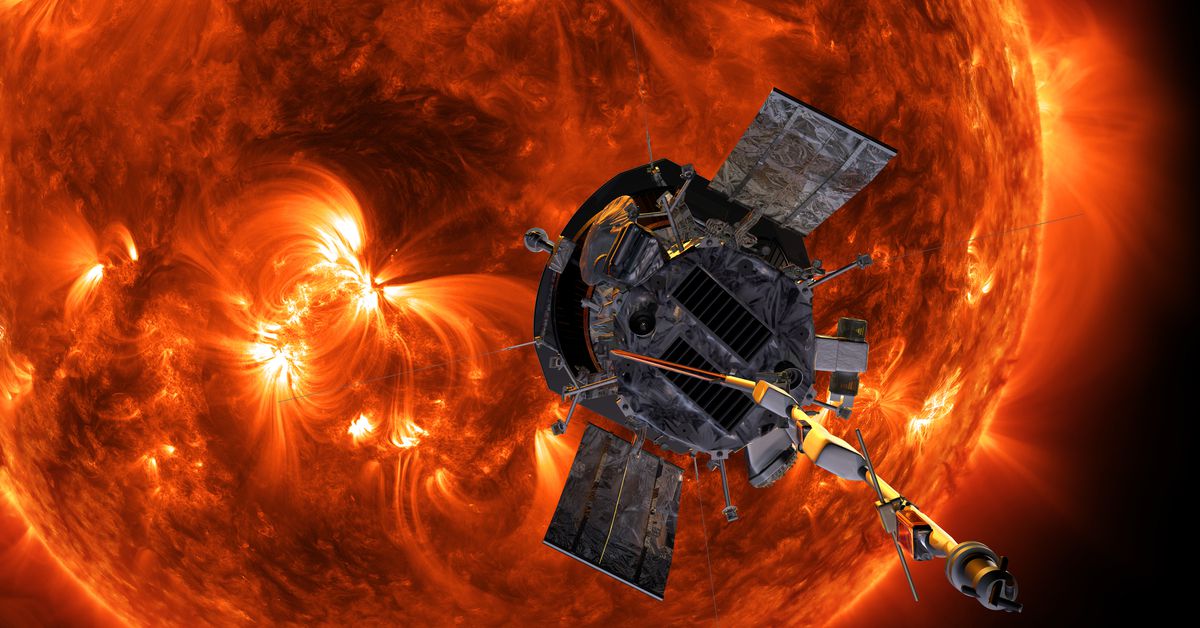NASA’s Parker Solar Probe Surveys the Sun at Record Proximity
A Historic Achievement in Space Exploration
On December 24th, NASA’s Parker Solar Probe executed a daring maneuver, flying an unprecedented 3.8 million miles from the surface of the Sun. This remarkable achievement marks not only a milestone for space exploration but also highlights the ingenuity and technological prowess of human innovation.
The Mission: Unveiling the Secrets of the Sun
Launched in 2018 as a collaborative effort between NASA and Johns Hopkins Applied Physics Laboratory, the Parker Solar Probe has been designed to tackle some of the most fundamental questions surrounding our solar system. One of the primary objectives is to understand why the corona – the outer atmosphere of the Sun – reaches temperatures of millions of degrees Fahrenheit while its surface remains relatively cool.
The Closest Flyby: A Glimpse into the Sun’s Mysteries
The Parker Solar Probe has successfully executed a close flyby, passing just 3.8 million miles from the Sun’s surface. This proximity allows scientists to gather crucial data on solar wind, the intense heat emanating from the Sun, and the mechanisms that accelerate energetic particles to near light speed.
Surviving the Extreme Conditions
To withstand the extreme conditions surrounding the Sun, the Parker Solar Probe is equipped with a cutting-edge Sun-facing heat shield. This innovative design allows the probe to operate within an incredibly narrow temperature range, maintaining a comfortable 85 degrees Fahrenheit while its surface shield reaches scorching temperatures of around 2,500 degrees Fahrenheit.
Confirmation of Mission Success
On December 26th, NASA received confirmation that the Parker Solar Probe had transmitted a signal back to Earth. This reassuring message indicates that the probe is in good health and operating normally. The mission team can now breathe a sigh of relief as they prepare for the next phase of data collection.
Expectations for Future Data Transmission
As the New Year approaches, NASA anticipates receiving more detailed telemetry data from the Parker Solar Probe on January 1st. This will provide scientists with an even deeper understanding of the Sun’s mysteries and shed light on some of the most pressing questions in space exploration.
A Groundbreaking Achievement in Space Exploration
The success of this mission marks a groundbreaking achievement in space exploration, showcasing human ingenuity and the remarkable capabilities of modern technology. As we continue to push the boundaries of what is possible in space research, we are reminded of the importance of curiosity-driven innovation and the limitless potential for discovery.
A New Era in Space Exploration
The Parker Solar Probe’s historic flyby sets the stage for a new era in space exploration. By pushing the limits of our understanding, scientists can unravel some of the most fundamental secrets surrounding our solar system. As we continue to venture closer to the Sun and other celestial bodies, we are reminded that the universe remains full of mysteries waiting to be unraveled.
Key Takeaways from the Mission
- The Parker Solar Probe has successfully executed a close flyby at a record distance of 3.8 million miles from the Sun’s surface.
- The probe has transmitted a signal back to Earth, indicating it is in good health and operating normally.
- Scientists anticipate receiving detailed telemetry data on January 1st, providing a deeper understanding of solar wind, heat, and energetic particle acceleration.
- The mission marks a groundbreaking achievement in space exploration, showcasing human ingenuity and technological prowess.
The Future of Space Exploration
As we continue to explore the mysteries of our solar system, the Parker Solar Probe’s historic flyby serves as a testament to human innovation and perseverance. By pushing the boundaries of what is possible, scientists can unlock new discoveries and shed light on some of the most fundamental questions surrounding our universe.
A New Frontier in Space Research
The success of this mission opens up new avenues for space research, providing scientists with an unparalleled opportunity to explore the Sun’s mysteries. As we venture closer to the Sun and other celestial bodies, we are reminded that the universe remains full of secrets waiting to be unraveled.



